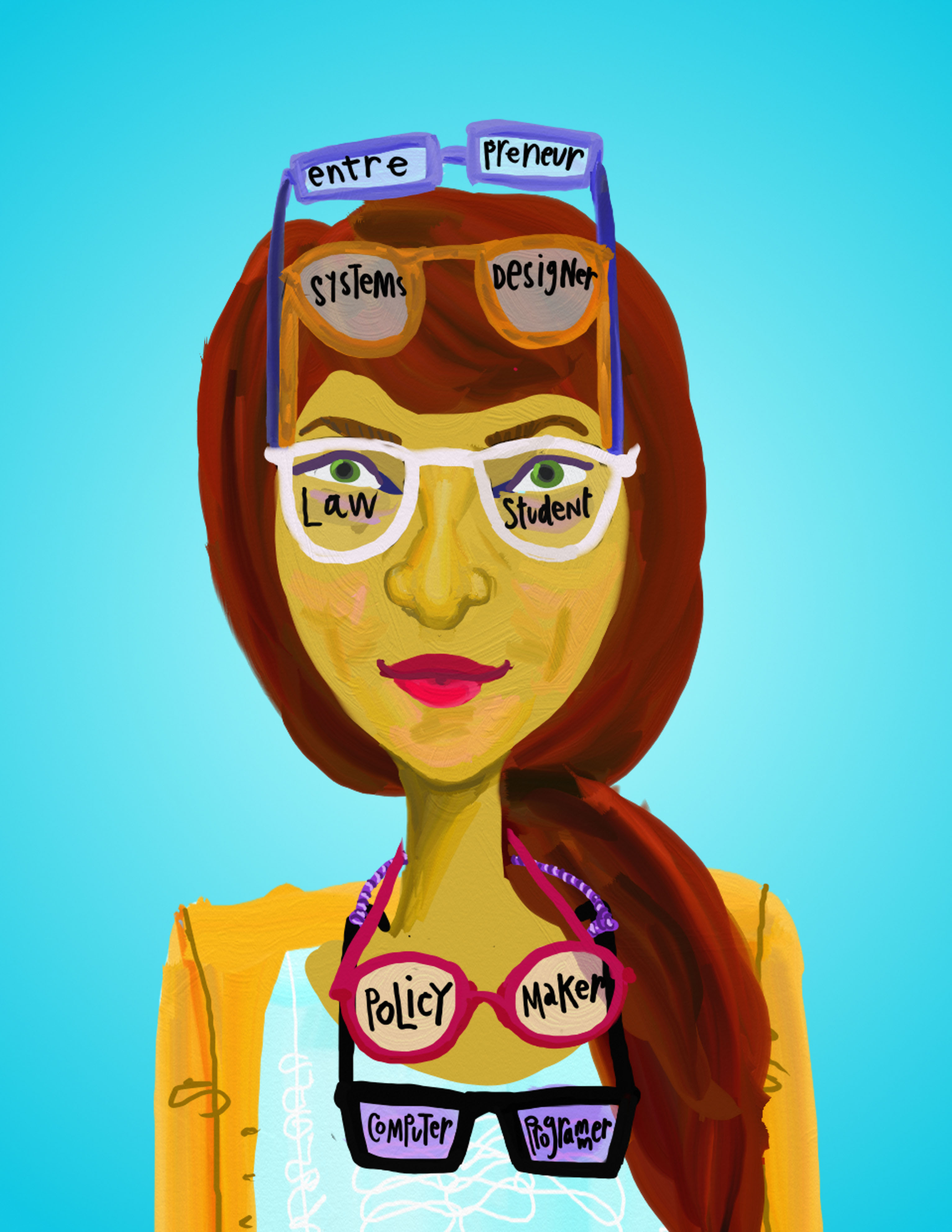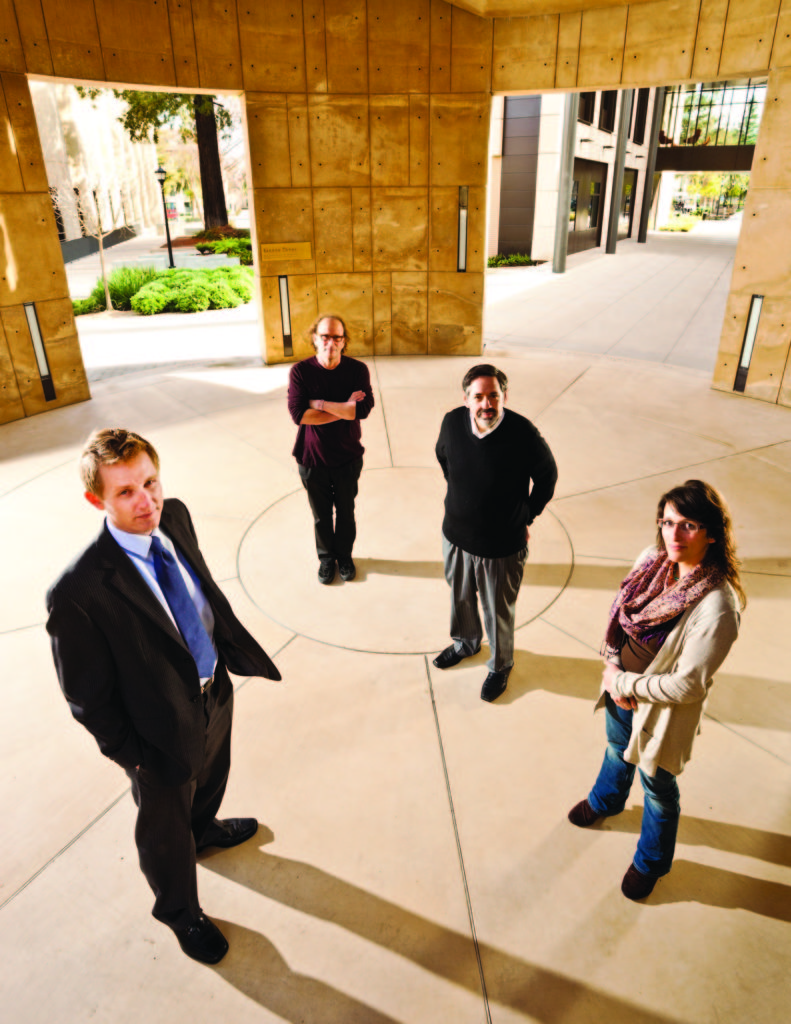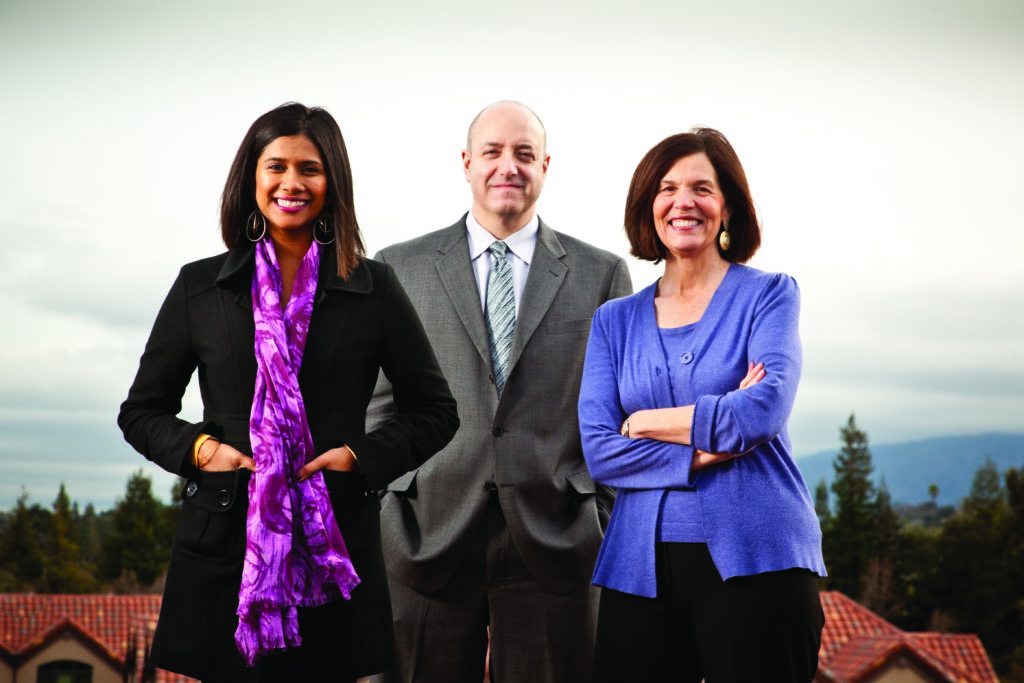The New JD

Jonathan Leland knew he wanted something more from his legal studies. “It’s hard to break out of the traditional law school escalator. I came to Stanford because it offered the best opportunity to forge a more entrepreneurial path out of school.” Leland, JD ’12, grew up in Washington, D.C., and graduated from Wesleyan University in 2005. Before coming to law school, he worked as a Web designer in New York and on a project setting up an NGO to provide opportunities for high school students in South Africa.
Leland has embraced the opportunities now on offer at Stanford Law with both arms, taking classes at the design school, the business school, and even a class on mindfulness meditation at the medical school. He participated in the Environmental Law Clinic and wrote and successfully argued a motion battling a major polluter of rivers and wetlands. He spent his first summer working on violent crimes and terrorism at the U.S. Attorney’s Office in New York. During his second summer, at New York’s Cleary Gottlieb Steen & Hamilton, he did both M&A work for Google and pro bono work on an environmental justice project for the nation of Palau. Currently, he’s weighing whether to take the job offered to him by Cleary or start fundraising full time for a social networking company he’s putting together with several computer science students he met in a design class. He’ll probably do both.
Leland may be more adventurous than some law students. However, formal interdisciplinary programs and more mingling of students from other schools are key elements of Stanford Law School’s new curriculum. Today’s Stanford Law offers a wide array of opportunities to explore not only the kind of law students hope to practice but also to learn more about the kinds of clients they’ll work for and the dynamics of the world they will enter (watch Dean Kramer’s video on preparing students for today’s legal profession). These opportunities are part of an eight-year overhaul of legal education at the law school that is helping JDs to hit the ground running after graduation, whether in a firm, in public interest law, or even in their own business. Options range from working in full-time legal clinics on campus to externships, to international travel study, to interdisciplinary courses deliberately populated with students from other professional schools, to new research courses focused on real problem solving. One recent course provided research support and policy recommendations for a pretty impressive client— California’s Office of the Attorney General. Another course, Designing Liberation Technologies, co-listed with Stanford’s design school, puts law students with graduate students from across campus for project teamwork aimed at using technology to solve social challenges in developing countries.
“We think lawyers have a valuable role to play in helping to solve the world’s problems and that calls for more than knowing how to analyze case law,” says Larry Kramer, Richard E. Lang Professor of Law and Dean. “Lawyers have always been leaders, whether in the legal profession or in government, business, the academy, or elsewhere. A legal education, with its focus on critical thinking and understanding of law, intellectually prepares graduates for many things. Our new curriculum recognizes that we still need to prepare our students well for a very competitive legal job market—but we also need to prepare them for careers beyond that.”
GETTING STARTED
In 2004, Kramer’s “to do” list was full. As the new dean he spent most of his time talking with his colleagues at Stanford Law as well as the school’s alumni to determine priorities for his tenure.
The conversations were enlightening: Sure, times were good, but the legal profession was evolving and legal education wasn’t keeping up. The dramatic changes to the curriculum that followed were driven by the insights of some of the most respected legal scholars and practitioners in the country. Timing for this curriculum overhaul was, perhaps, predictive. While starting salaries for lawyers were soaring (hitting $160,000 plus bonuses in 2006), law firms were starting to cut back their training programs and to explore ways to economize using technology and off-shoring. Hiring partners wanted law schools to do more to prepare JDs for the actual work they’d do as new associates. Other conversations focused on the need for lawyers to understand the business of their clients—as Kramer puts it “not only to think like a lawyer but also like a client.” This understanding is particularly relevant in Silicon Valley—where a significant percentage of Stanford Law JDs wind up—with start-up lawyers wearing many hats while helping entrepreneurs launch companies.
So, Kramer and the law school faculty agreed on key programmatic and curriculum changes even though there were no compelling economic reasons for them—at least not yet. Fast-forward four years to one of the toughest legal hiring markets in recent history and Stanford Law students are now better prepared to compete for the shrinking jobs available—and also to forge their own careers either in law or another area.
While the changes made to the Stanford Law curriculum are still too new to be borne out in statistics, Susan Robinson, associate dean for career services at Stanford Law, says more and more law students are talking to her about starting their own companies and nonprofits or entering specialized realms such as venture capital. (Robinson notes that the number of students who do “non-law business” right after graduation is still less than 4 percent and the majority, usually about 55 percent of each graduating class, will have an associate position at a law firm after graduating; another 30 percent secure clerkships; around 10 percent go into public or government service; and the rest are evenly split between non-law business positions and academia.) Robinson wonders if perhaps just as Stanford Law was ahead of the curve in rethinking the practical aspects of its curriculum, better preparing its students for a tough job climate, it will also prepare its students for a more entrepreneurial future in law—and beyond the law.
ONE UNIVERSITY
Ellen Medlin, JD/MS ’10, an associate attorney for the Sierra Club’s headquarters in San Francisco, obtained both her JD and a master’s degree in Stanford’s Emmett Interdisciplinary Program in Environment and Resources, taking classes in ecology, economics, and business in addition to law.
“The joint degree opportunity was the reason I chose Stanford,” she explains. “Now, I use my interdisciplinary training every day in assessing potential litigation for the Sierra Club, where our goal is to protect the environment, not just win cases. My science and policy background helps me evaluate whether new litigation will really achieve our environmental goals.”
Gordon Davidson, JD ’74 (BS ’70, MS ’71), managing partner of Fenwick & West who advised Kramer on changes to the second- and third-year programs, feels confident that today’s program can now give students a far more realistic context for their legal education. He helps teach a class in mergers and acquisitions, for example, in which 40 percent are business school students. The blended disciplines “made the course much more like the real world and created a rich dialogue in class. We required the law students and business school students to pair up in projects.” Davidson laughs that he has already run into one of his former students working on a deal for another law firm. “Law students are arriving in our firm much better prepared to practice law than I did thirty-seven years ago,” he says.
Employers like not only the varied backgrounds that more and more law students have but in many cases the high level of expertise they’ve already developed in another discipline. In the past six years there has been a ninefold increase in the number of students enrolled in joint degree programs—and today nearly all students take at least some classes outside of the law school. “In almost any area of the law that you can envision young law school graduates going into—the more the lawyers really do understand the underlying subject matter, the substantive matter that is involved, the more effective they will be and the more quickly they will become effective as young lawyers,” says chairman of Cooley LLP, Stephen C. Neal, JD ’73.
“We can say, ‘Come here and figure out what kind of lawyer you want to be and you can tailor your experience.’ And you can do so knowing that each option is going to be of the best possible quality, with all of Stanford’s graduate programs highly ranked. No other law school can match that,” says Kramer. Offering more joint degrees and more interdisciplinary study, essentially leveraging the excellence of the wider Stanford campus, involved one perhaps under-appreciated element of this overhaul—synchronizing the law school’s calendar with that of the broader university in 2009 and shifting from semesters to quarters. Davidson, a big fan of that shift, recalls the challenges he experienced 20 years earlier: “My frustration was how to take a couple of courses at the business school without doing an entire JD/MBA year.”
Mark G. Kelman, James C. Gaither Professor of Law and vice dean, quarterbacked that transition, which involved a number of tricky factors including the faculty having to rethink courses to work in shorter time frames. Also, making sure the change did not hurt students in terms of summer placements and state bar requirements involved no small amount of work. “We understood that the second and third year of law school were too repetitive. So we reshaped, and I think reinvigorated, the 2L and 3L years,” says Kelman, who admits he was not a proponent of switching to quarters. But he made it happen when the faculty voted for the change. Today, he observes, “The biggest changes have been a growth in the problem-solving classes that are collaborative and more interdisciplinary.”

LEARNING THROUGH PRACTICE
Clinical work is important for creating an intellectually rich but more experiential learning path.
“The traditional curriculum and method of teaching have a lot to offer but need not be repeated thirty times over three years,” says Lawrence C. Marshall, David & Stephanie Mills Director of the Mills Legal Clinic, associate dean for clinical education, and professor of law. Marshall has helped build Stanford Law’s clinical program, substantially increasing both the number and range of clinics offered. The expanded set of legal clinics is now given on a full-time basis for one quarter—involving students in real client representation. (Listen to students comment on experiences in the Mills Legal Clinic.) Today’s Stanford Law students can pick from an array of clinics aimed at youth and education law, environmental law, organizations and transactions, criminal prosecution, international human rights, immigrants’ rights, community law, and U.S. Supreme Court litigation, along with two soon-to-be-added new clinics in criminal defense and intellectual property. The clinical program is important, Marshall continues, not because it offers a “sneak preview of what their careers are going to look like” but rather a chance to “develop professional expertise and habits of reflection, best practices, and ethics.”
Julie Matlof Kennedy, JD ’91 (BA ’87), of counsel for litigation training at Morrison & Foerster and a lecturer at Stanford Law in negotiation, agrees that the new emphasis on experiential learning is a potent tool. “Ninety-nine percent of the work in litigation is in writing compelling briefs and letters, taking depositions, and communicating with clients. By actually working with clients, the students come to realize that sometimes clients want something that doesn’t even occur to you as a lawyer. They want a business outcome, for example, and they’re not terribly interested in your analysis of a split in authority between circuit courts.”
According to those who do post-graduation hiring, Kramer’s often-mentioned goal of teaching students to think not only like lawyers but also like clients is paying off on the job. John F. O’Toole directs the Oakland, California-based National Center for Youth Law, which aims to ensure that children in need get the resources, opportunities, and support necessary to be successful in life. For 30 years, he has hired Stanford and other law students for full- and part-time internships and fellowships and sometimes as staff attorneys. O’Toole says Stanford students are “uniformly excellent,” but those who have taken the Youth Education Law Project arrive ready for work on day one.
“Because the students have actually worked with clients, they are more grounded and able to do research in a more practical way. We place a high value on their analytic ability, and they must research and write well. But their work has to be informed with a realistic understanding of what you will do with this. Students who have not had that experience tend to do research that is much more abstract.”
Julia Wilson, JD ’98, executive director of the public advocacy law firm OneJustice in San Francisco, had a front row seat to the shift. After obtaining her JD, she went to the Legal Aid Society of San Mateo County and did her part by hiring a number of SLS students for internships. During those years she grew increasingly impressed with the changes and additions to the SLS curriculum that were producing more client-focused, practical lawyers. These days, Wilson returns to the law school to lecture in the Organizations and Transactions Clinic, which provides governance advice, contract drafting, transaction plans, as well as operating program analysis and contractual arrangements for established Northern California nonprofit organizations.
LAW AND INNOVATION

Research seminars are another hallmark of Stanford Law’s new program.
For example, one innovative project is a practicum taught by Joan Petersilia, Adelbert H. Sweet Professor of Law and faculty co-director of the Stanford Criminal Justice Center. The course was organized as a provisional policy think tank. Last fall, “clients” for the course were California Attorney General Kamala Harris and the County of Santa Clara Community Corrections Partnership, both of which are grappling with a new “realignment” law bringing thousands of state prisoners back to county jails and probation departments.
Nayna Gupta, JD ’13, teamed up with Endria Richardson, JD ’13, to research such topics as how to empirically assess the recidivism risk of convicted felons and what the most pressing housing, health care, and job barriers are for returning prisoners. Gupta’s particular focus was the housing situation for parolees returning to communities where available housing might be physically located too far away from services essential for a successful reentry, including drug treatment, mental health support, and job training. “I loved trying to solve a real-world problem,” says Gupta, who, before coming to SLS, worked in civil rights impact litigation and also on a microfinance project in Lima, Peru. “It was exciting to present to the AG. She was very engaged and had a lot of follow-up questions, focused on ‘so, what should we do going forward.’ ” Observes Dean Kramer, “We were teaching students how to think in class; now we teach them how to think in context.”
IMPORTANCE OF PUBLIC INTEREST
Critics of legal education claim that there are already too many lawyers in the United States.
But that claim contrasts vividly with the reality that many Americans don’t have access to adequate legal representation. John P. Levin, JD ’73, (MA ’70), who helped shape the law school’s approach to public service and the launch of the John and Terry Levin Center for Public Service and Public Interest Law, says, “We need to emphasize that law is a profession and a service, first and foremost. We shouldn’t simply focus on equipping students to get jobs in law firms but infuse in them an understanding that practicing law is about helping others, whether in the public or private sector.” Levin, who is chairman of Folger Levin in San Francisco, worries that profit pressures have driven many law firms to lose sight of their core mission as social servants.
“My hope is that Stanford students choosing to join private firms will do so with the goal of not only being the best lawyers they can be but also with a strong sense of the critical public purpose inherent in the practice of law,” says Levin. “If that happens everyone will win—firms, individual lawyers, clients, the profession, society. And Stanford will rise to its real mission, educating and producing leaders with vision and values, capable of making a difference.” Along with counseling the growing number of students interested in careers in public and government service, the Levin Center also promotes pro bono work and many Stanford JDs look to join firms that encourage that legal service.
A LESS PREDICTABLE CAREER PATH
Ironically, one thing Jonathan Leland learned at Stanford is to look beyond the law and to pursue his entrepreneurial aspirations.
And he is no longer sure he’ll ever practice law. He says that while working on another design school project developing medical solutions to childhood disease in the slums of Kenya, he realized that “legal training really does help you learn to think through an issue from virtually any angle; you learn to distill what’s important from a complex problem or data set; you look at a huge text and you have to find what the case turns on.” By working with students from other schools, Leland explains, he could see the strength of a legal training. “I share the risk aversion of lawyers,” Leland says. “But I also resist it.” SL
This cover story is accompanied by the sidebar “The Stanford Challenge.”
